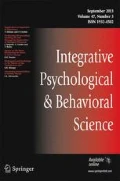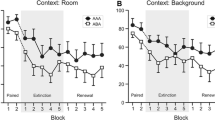Abstract
In classical eyeblink conditioning, non-specific emotional responses to the aversive shock unconditioned stimulus (US), which are presumed to coincide with the development of fear, occur early in conditioning and precede the emergence of eyeblink responses. This twoprocess learning model was examined by concurrently measuring fear and eyeblink conditioning in the freely moving rat. Freezing served as an index of fear in animals and was measured during the inter-trial intervals in the training context and during a tone conditioned stimulus (CS) presented in a novel context. Animals that received CS-US pairings exhibited elevated levels of fear to the context and CS early in training that decreased over sessions, while eyeblink conditioned responses (CRs) developed gradually during acquisition and decreased during extinction. Random CS-US presentations produced a similar pattern of fear responses to the context and CS as paired presentations despite low eyeblink CR percentages, indicating that fear responding was decreased independent of high levels of learned eyeblink responding The results of paired training were consistent with two-process models of conditioning that postulate that early emotional responding facilitates subsequent motor learning, but measures from random control animals demonstrate that partial CS-US contingencies produce decrements in fear despite low levels of eyeblink CRs. These findings suggest, a relationship between CS-US contingency and fear levels during eyeblink conditioning, and may serve to clarify further the role that fear conditioning plays in this simple paradigm.
Similar content being viewed by others
References
Bouton, M.E. & Bolles, R.C. (1980). Conditioned fear assessed by freezing and by the suppression of three different baselines.Anim. Learn. & Behav., 8(3), 429–434.
Chen, G. & Steinmetz, J.E. (1998). A general purpose computer system for behavioral conditioning and neural recording experiments.Behav. Res. Methods. Instrum. Comput., 30, 384–391.
Christiansen, B.A. & Schmajuk, N.A. (1992). Hippocampectomy disrupts the topography of the rat eyeblink response during acquisition and extinction of classical conditioning.Brain Res., 595, 206–214.
Cohen, D.H. (1980). Functional neuroaatomy of a conditioned response. In R.F. Thompson, L.H. Hicks, & V.B. Shvyrokov (Eds.),Neural Mechanisms of Goal-Directed Behavior and Learning, New York: Academic Press.
Davis, M. (1992). The role of the amygdala in fear and anxiety.Ann. Rev. Neurosci., 15, 353–375.
Fanselow, M.S. (1980). Conditional and unconditional components of post-shock freezing.Pav. J. of Biol. Sci., 15, 177–182.
Good, M. & Honey, R.C. (1991). Conditioning and contextual retrieval in hippocampal rats.Behav. Neurosci., 105 499–509.
Goosens, K.A. & Maren, S. (2001). Contextual and auditory fear conditioning are mediated by the lateral, basal, and central amygdaloid nuclei in rats.Learn & Mem., 8, 148–155.
Kazis, E., Powell, D.A., & Milligan, W.L. (1973). Autonomic-somatic relationships: Blockade of heart rate and corneo-retinal potential.J. Comp. Phys. Psych., 84, 98–110.
Lavond, D.G., Lincoln, J.S., McCormick, D.A., & Thompson, R.F. (1984). Effect of bilateral lesions of dentate and interpositus cerebellar nuclei on conditioning of heart-rate and nictitating membrane/eyelid responses in the rabbit.Brain Res., 305, 323–330.
Lee & Kim (2004). Differential effects of cerebellar, amygdalar and hippocampal lesions on classical eyeblink conditioning in rats.J. Neurosci., 24(13), 3242–3250.
Maren, S., DeCola, J.P., & Fanselow, M.S. (1994). Water deprivation enhances fear conditioning to contextual, but not discrete, conditional stimuli in rats.Behav. Neurosci., 108(3), 645–649.Behav. Neurosci., 106, 274–285.
Phillips R.G. & LeDoux, J.E. (1992). Differential contribution of amygdale and hippocampus to cued and contextual fear conditioning.
Rescorla, R.A. & Solomon, R.L. (1967). Two-process learning theory: relationships between Pavlovian conditioning and instrumental learning.Psycho. Rev., 74, 151–182.
Rogers, R.F., Britton, G.B., & Steinmetz, J.E. (2001). Learning-related interpositus activity is conserved across species as studied during eyeblink conditioning in the rat.Brain Research, 905, 171–177.
Schneiderman, N., Fuentes, I., & Gormezano, I. (1962). Acquisition and extinction of the classically conditioned eyeblink response in the albino rabbit.Science, 136, 650–652.
Schneiderman, N., Smith, M.C., Smith, A.C., & Gormezano, I. (1966). Heart rate classical conditioning in rabits.,Psycho. Sci., 6, 241–242.
Thompson, R.F. (1986). The neurobiology of learning and memory.Science, 233, 941–947.
Thompson, R.F., Berger, T.W. & Madden IV, J. (1983). Cellular processes of learning and memory in the mammlian CNS.Ann. Rev. Neurosci., 6, 447–491.
Thompson, R.F. & Kim, J.J. (1996). Memory systems in the brain and localization of memory.Proc. Natl. Acad. Sci. USA, 93, 13438–13444.
Thompson, R.F. & Krupa, D.J. (1994). Organization of memory traces in the mammalian brain.Ann. Rev. Neurosci., 17, 519–549.
Weisz, D.J., Harden, D.G., & Xiang, Z. (1992). Effects of amygdala lesions on reflex facilitation and conditioned response acquisition during nictitating membrane response conditioning in rabbit.Behav. Neurosci., 106(2), 262–273.
Author information
Authors and Affiliations
Rights and permissions
About this article
Cite this article
Britton, G.B., Astheimer, L.B. Fear develops to the conditioned stimulus and to the context during classical eyeblink conditioning in rats. Integr. psych. behav. 39, 295–306 (2004). https://doi.org/10.1007/BF02734168
Issue Date:
DOI: https://doi.org/10.1007/BF02734168




